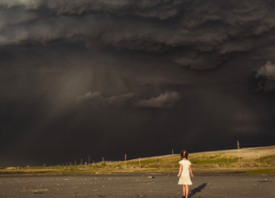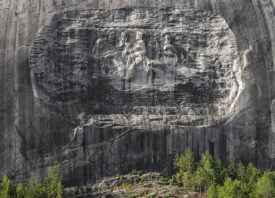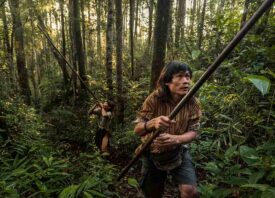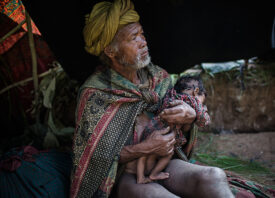Search this site
‘Living Wild’ With 21st Century Hunter-Gatherers


Kiliii Yuyan lives a life less ordinary. As a native Russian descendent of “the salmon people who live along the Amur river in Siberia”, yet raised in America, Yuyan grew up chasing the traditions of his culture and seeking an answer to the question: “can a modern person learn to see the world through native eyes?”
Yuyan has spent ten years involved with a group of 21st Century hunter-gatherers, a movement called the Stone Age Living Project. Their aim is to return to primitive living, away from the modern age. In the summer of 2014, Yuyan embedded himself with the group for a month, for which they had spent six months in preparation. They tanned hides and collected and dried foods in anticipation of the month ahead. During the month itself they hunted, “strained [their] way up scree slopes in bloodied bare feet”, and lived primally. Yuyan chose to carry a camera rather than a weapon, and with it he recorded their activities.
The result – a project called Living Wild – is striking. The photographs themselves are largely rendered in high definition, clear digital images enhanced in post-processing. This visual crispness is in contrast to the delicate colors they record: of the vast skies, the sunlight, and the wind blown through hair of a month in the wild. Formal portraits – of the participants in their hides, their gaze direct and proud – are alternated with dynamic shots in situ, in which the community can be seen enacting the basics of their simple lives: hunting, sleeping, foraging, making fires. Yuyan affords us a rare glimpse into a way of life that would be unthinkable for most. To have such a close insight into a community that so values an escape from the modern age is, surely, a privilege.

Were you involved in the Paleolithic movement before you began to photograph it? When did you start photographing it?
I found the ancestral skills movement over fifteen years ago. I was searching for my roots through traditional land-based practices as both a Nanai (Siberian Native) and Chinese person. Eventually I became a photographer and after several years I realized that I couldn’t escape turning the lens on this aspect of my life, despite the inherent challenges.
How did your fellows react to your taking pictures? Did the modernity of the camera equipment interfere with the back-to-nature experience?
A lot of the ancestral skills world is averse to publicity. Despite this, I’ve been deeply involved with the community and they trust me to tell their stories. For a first-world audience, it’s easy to be aghast at the butchering of a deer or to romanticize the spirituality of a hunter-gatherer ethos. It’s my mandate to help people see past their own cultural biases and interpret this mode of living close to the land.
The camera changes the nature of every experience, most especially in a survival situation where every person is needed to help the group survive. I had to make the choice from the outset of whether to bring my hunting bow or not. To bring my bow meant the odds of eating were much higher, but it was either camera in hand or bow in hand. I chose the camera.

How do you feel like your impulse to photograph impacts on your wish to “see the world through native eyes”?
I’ve spent time with and become friends with the Iñupiat and Yu’pik of Alaska, the Sami of Finland and Sweden, and of course much of the Native Community here in the Northwest. I’ve learned so much from them but also taught traditional skills back to those communities. A lot of my connections happened because of the camera. The camera is a major driving force for me. It compels me to get to know new people and communities in a way that I never would have were I not a photographer.
Is your project, Living Wild, finished? How did you know you had achieved what you wanted to achieve?
Living Wild is not complete. There remains an enormous wealth of things Living Wild does, from reindeer husbandry with Lapland’s Sami to coastal subsistence. The project evolves and I will be shooting this for many years to come. The hard part is carving out the time when I have other projects that I also love dearly.

What are you hoping to suggest with your project? Does it have a meaning beyond the plainly documentary?
I think that there’s a lot to learn from the experiment that is Living Wild. It gives us inspiration that there’s alternative ways to live, it gives us insight into ancient practices that continue to vanish every day.
I hope that this work will tie into my work with indigenous cultures and highlight the importance of cultural practices that stem from the land. I also want to see some questions debated.
Why are modern people interested in hunter-gatherer lifestyles? For those that aren’t interested, why is there such a strong reaction against? What do we as a species lose when we lose these cultural practices that evolved among people for thousands of years?

Who or what inspires your photographic work? Why do you use the medium of photography?
When I began as a commercial photographer I chased adventure shoots simply to be outside and in nature. Ultimately, I had to come around to my core being. As an indigenous person with a bent towards anything wilderness, I am finding my way in a world careening towards concrete and sameness. I finally had to start shooting the things that were dear to me and take the scary step of becoming a journalist. The inspiration is everywhere that nature is.
Although I sometimes I wish I was a writer, I find photography to be very straightforward and truthful. When I am wearing my photojournalist hat, I find making photographs forces me to face reality but pull back on interpretation. That’s powerful. Besides that, I’m quite a visual person and I find magic in the still image.
What were your aesthetic inspirations for the series?
With Living Wild I was definitely inspired by Edward S. Curtis, taken with some irony. With the portraits I asked my subjects to remain still for several minutes and let them settle into a sort of tension. For much of my other work I am inspired by other photographers of land-based cultures, namely Aaron Huey and Erika Larsen, but there are many greats that move me.







All images (C) Kiliii Yuyan.



